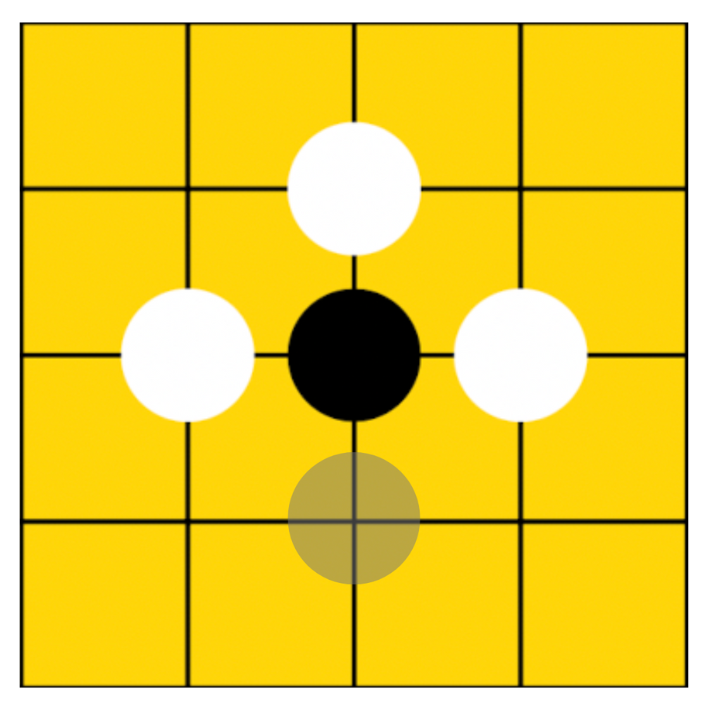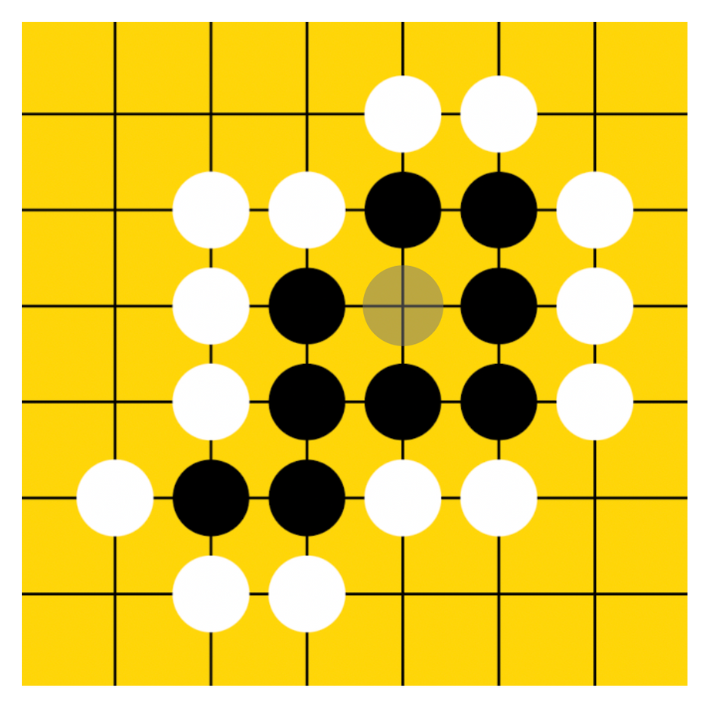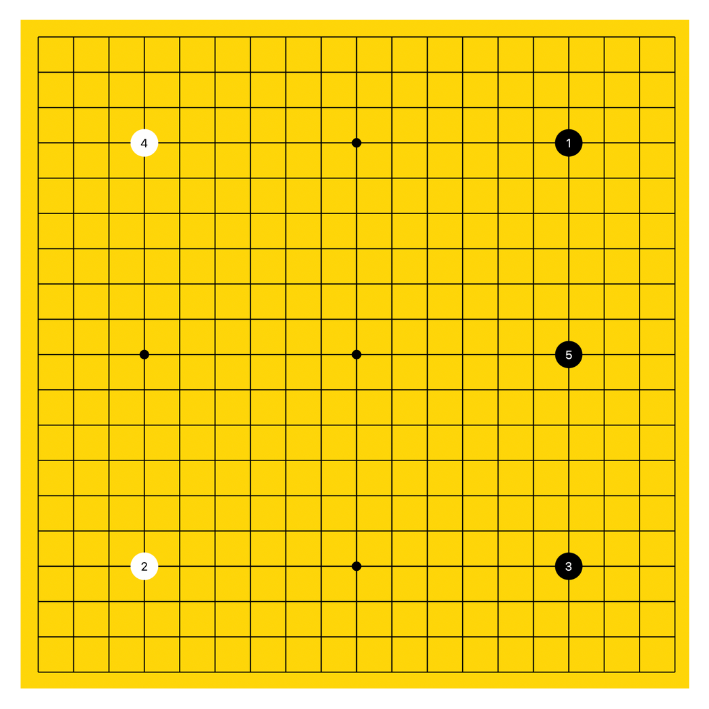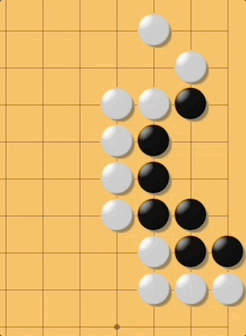Evaluating Life Through a Game of Chess.
Let's talk about Go.
No, not the programming language, but the over 4,000 year old board game once responsible for uniting Tibet.

Black and white stones scattered in a seemingly senseless pattern on a 19x19 grid—to the untrained eye,
a game of Go may as well be the abandoned afternoon activity of a bored toddler. Those who understand
the game, however, are immediately transported into an exciting world of strategy, deception, and tactical maneuvering.
In this blog, we will explore the parallels between the strategic decisions made in Go and the choices we encounter at various stages of our lives.
Rules
The game of Go is simple. It’s Chinese name, 圍棋 (wei2 qi2) or “surrounding chess”, quite literally sums
up the objective of the game. The game starts with an empty 19x19 board—although it has become common for
younger players to learn on smaller board sizes, such as 9x9 or 13x13. Each side is given an unlimited
amount of stones, either black or white respectively. The objective is to use your stones to effectively
surround as much “territory” (possible grid spaces) as possible. There are only two rules to the game:
- The players must take turns making one move each, starting with the black side
- All stones can be placed anywhere on the grid, but once placed may not be moved, unless:
- When a stone, or group of stones, are fully surrounded by the opponent with no possible moves left, they are captured by the opponent, and must be removed from the board.
"Capturing"
The concept of capturing can be pretty difficult to grasp. It is easier to think of possible connected moves as “breaths”. When a stone is out of “breath”, it can no longer stay “alive”. The following images can help explain this concept better.

In the image above, if white advances onto the translucent circle, it will successfully “capture” the black stone, as the black stone will be fully out of “breath” (possible moves). On the contrary, if it is black’s turn and they advance on the the translucent circle, they will have extended their possibilities by 3 additional paths, thus gaining 3 “breaths”.
In order to ensure the survival of a larger group of stones, players often create pockets of “air”. One pocket is not enough, however, as your opponent may still place their stone within the pocket to capture the entire group. See image below for better understanding.

If white advances onto the translucent circle, it will successfully capture the black stones. It is illegal for black to move onto the translucent circle themselves, as it will essentially be “suicide”. Therefore, players often try to create at least two pockets of air per group, as their opponent is only allowed one stone per move, and it would be illegal to place their stone in only one pocket of air for the same reason illustrated prior.
Life or Death puzzles
More complex puzzles devised to practice this very concept are called “Life or Death” puzzles. The player is assigned a side, and the objective would be to either capture the opposite side, or to stay alive. These puzzles are a quick and fun way to practice calculating multiple steps ahead—an important skill for any experienced Go player.The following is an example of such a puzzle. See if you can figure it out! The objective is for black to successfully create two separate pockets of air. I will reveal the answer at the end of this blog!

Opening
A game of Go can be separated into 3 general stages—opening, middle, and endgame. The opening is the beginning stage of the game where players try to claim areas of the board they would like to develop as the game progresses. During this stage, players often have to choose between maintaining a safer, more defensive stance or a more aggressive stance that might benefit future expansion.
Unlike the more popular Western chess, the freest phase of a game of Go is the opening. In chess, each game begins with every piece starting at a preset position. As the board is filled, there isn’t much room for variability in the first couple moves of the game, leaving the opening stage feeling constricting for many. On the other hand, Go starts with endless possibilities on an empty board, allowing the player to sculpt their game and build their strategy from the ground up.
Although the opening is technically the most free stage of the game, more experienced players often choose to stick to universally recognized patterns of balanced opening moves, known as 佈局 (bu4 ju2) in Chinese. This phenomenon is due to players recognizing and selecting the most efficient and equally advantageous ways for both parties to achieve their respective objectives. In fact, these universal openers are so widely accepted that it is almost bizarre to see a player not adhere to their set pattern of moves.
There are numerous sets of openers available for players to choose from. Some are more passive, laying low to the edges of the board, where territory is easier to defend (as opponents can only attack from above). Others are more aggressive, positioning stones in preparation to occupy the more central territory within the board. This approach is more risky, as although the central territory is much larger, it is also the most difficult position to defend.
Opening examples
The following opening sequence is a prime example of a defensive and careful position taken by both sides. Both players chose repeatedly to place their stones on what we call the “star” (4 lines up from both edges of the board), universally accepted as the easiest positions to defend without missing out on too much territory. In addition to being relatively easy to defend, it is also very adaptable, as the player could choose to shift their focus either upwards towards the board or downwards towards the sides. For example, white could choose to attack black’s position, or maintain their defensive position and occupy the middle star. As a result, this sequence is most commonly seen amongst beginners, as they can best leverage the advantages it brings.
Additionally, each approach has multiple variations that carry out a similar general purpose. More skilled players are able to leverage more complicated stances, like the one below.

Players who choose to adhere to these traditional openings are often individuals who are more careful and grounded in nature. On the contrary, those who choose to deviate from the norm tend to display more crafty and adaptive qualities.
The opening stage of the game can also be deceptive, as the vast array of possibilities can create an illusion of unlimited opportunities for the player. In Go, giving due consideration to the opening enables the player to establish a solid foundation upon which their middle game strategies can flourish. Similarly, in life, people often overlook opportunities in their youth, lured by the false perception of having an abundance of time at their disposal. Those who are able to recognize this, however, are able to best leverage their youth to position themselves for adulthood.
An iconic opening between two masters.
In 1933, a young and ambitious Go Seigen won the honor of challenging well-respected Japanese chess master Honinbo Shusai, ranked number one in the world at the time. In the eyes of most, there was not a chance at all that Go Seigen would walk away with anything less than utter defeat. However, Go Seigen had a distinct advantage that most overlooked. He was young and new to the scene. In contrast to Honinbo Shusai, who’s move sets and play styles have been thoroughly studied, Go Seigen had only recently made a name for himself in the professional Go scene.
Furthering their differences, Honinbo Shusai was trained in a traditional and prestigious chess school, where slight deviations from accepted move sets were seriously scorned—even punished in some cases. In stark contrast, Go Seigen was trained in a more modern and contemporary school, where students were encouraged to embrace their unique perspectives and styles.
Go enthusiasts from all over the world watched in anticipation at this clash between the old and the new. They knew this face off was destined to send shockwaves through the Go chess community. However, nothing could have prepared them for the utter shock that came within the first 5 moves of the game.

Go Seigen, holding black, set the tone of the game with three bold strokes, each more sacrilegious than the last. Being the classically-trained chess master that he is, Shusai played a conventional opening in response, adhering to the principles he had honed over years of experience.
The stark contrast in their opening moves is not only an extension of the extreme difference in their personalities and backgrounds. Many enthusiasts felt that the unconventional set played by Seigen was a sign of disrespect towards the traditional master and his approach to chess. Nevertheless, this game represents a pivotal point in the modernization of Go, inspiring players from all over the world to explore bolder strategies and to embrace creative freedom in their game.
Middle
The middle stages of Go are often the most hectic and aggressive. At this point in the game, the primary objective is to leverage the pieces placed during the set up to expand dominance across the board. Not only should you be reinforcing your stones, you should also be picking at your opponent’s formations, looking for any exploitable weaknesses.
During this stage, opportunities are most abundant for both yourself and your opponent. Likewise, chances for mistakes are also extremely high. Deception is the name of the game. Players frequently aim to outmaneuver and outsmart their opponents by employing various strategies such as setting traps, deliberately diverting attention to other areas of the board to mask their true intentions, and making precise calculations to seize the upper hand. It's a dynamic and intellectually demanding part of the game where ingenuity and strategic acumen take center stage.
Amidst the chaos, it is important to remember that you hold the same amount of chances as your opponent. Each side only gets one stone per turn, thus it is pivotal that every move is handled with tactical precision. Achieving a proper balance between offense and defense is key. Overcommitting to a defensive stance allows your opponent to seize command of the game. Attacking without a proper foundation, on the other hand, exposes you to vulnerabilities that your opponent can leverage to turn the tide.
Returning to the central theme of this blog, much like the middle stages of a game of Go, the middle stages of one's life are also brimming with a multitude of possibilities. It is easy to get swept up by the constant new and exciting opportunities, but much like in Go, it is important to stay grounded and consistent with the larger, overall objective. It is also important to recognize that it is unfeasible to seize every opportunity effectively. Learn to know when to let go and reallocate your resources to the opportunities that produce the most value for you.
Endgame
Unlike in the movies, the endgame phase of Go is typically pretty calm. By this point, much of the board is already settled. Both sides are usually just playing out their closing moves, like patching up any gaps in their line or squeezing out an extra territory point.
At this point in the game, any large efforts to make decisive plays are seldom seen. Most attempts to shift the outcome are futile anyway, as there usually are not many opportunities left on the board. In contrast, the endgame usually unfolds as a series of balanced and peaceful exchanges.
During this stage of the game, while staying vigilant of course, I like to take the time to reflect on the game. While I tidy up my borders, I like to retrace my steps and make note of any missed opportunities for self-improvement and learning.
Like in Go, the endgame stage in life is often spent in deep reflection and acceptance. In Go's endgame, the consolidation of territory is paramount. Similarly, in life’s later stages, individuals often focus on consolidating their achievements, securing their legacy, and ensuring the well-being of their loved ones. One is able to better navigate the intricate challenges of life by using the principles learned through playing Go.
Life or Death Answer

- Black positions itself to make two pockets of air (breaths)
- White threatens the unformed pocket of air
- Black connects the threatened piece and solifies the second pocket of air in the process
The Beauty of Go
The beauty of Go is that everyone thinks differently—each opportunity, along with the balance between offense and defense, will hold a distinct weight. Each side will make unique mistakes, each side will choose to make different sacrifices, each side will see different weaknesses on the board. It can get frustrating to overlook a hole in your defenses or to see your opponent seize an opportunity that had slipped your mind. However, it is important to remain level-headed and continue to allocate your resources where there is most opportunity. The variation in the game is just a reflection of the rich tapestry of human thinking and decision-making.